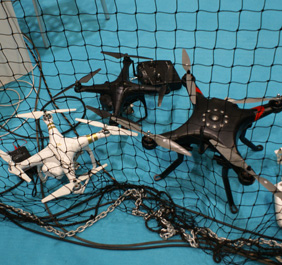Drones in the UK will have to be registered and users will have to sit safety awareness tests under new regulations. Details – such as how users register, whether online or through apps – are yet to be announced.
Department for Transport (DfT) Aviation Minister Lord Callanan said: “The UK is at the forefront of an exciting and fast growing drones market and it is important we make the most of this emerging global sector. Our measures prioritise protecting the public while maximising the full potential of drones. Increasingly, drones are proving vital for inspecting transport infrastructure for repair or aiding police and fire services in search and rescue operations, even helping to save lives.
“But like all technology, drones too can be misused. By registering drones, introducing safety awareness tests to educate users we can reduce the inadvertent breaching of airspace restrictions to protect the public.”
This follows a UK Government consultation. The UK Government also wants more use of ‘geo-fencing’ that acts like an invisible shield around buildings or sensitive areas. The technology, which works on GPS coordinates, is built into the drone and stops it from entering zones such as a prison or airport. Only some manufacturers have already programmed their drones not to fly in such sensitive areas. It’s been well documented that criminals are using drones to drop contraband drugs to inmates in prisons. Other security risks from drone use include damage to aircraft, even if not through malice but by inexperienced or bad pilots.
On that score, the DfT, British Airline Pilots’ Association (BALPA) and the Military Aviation Authority (MAA) has published a summary report of test results on drones and manned aircraft mid-air collisions. It admitted that unlike bird strikes, ‘the aviation industry is only beginning to understand the risks of drone collisions’. It concluded that ‘helicopter windscreens could be critically damaged by collisions with a drone in several realistic scenarios’ and ‘airliner windscreens could be critically damaged by mid-air collisions with 4 kilogram class quadcopter components, and 3.5 kilogram class fixed-wing drones with exposed metallic components at high, but realistic speeds’. The study found that ‘drone configurations and construction designs significantly affect the severity of a collision’, and called on drone manufacturers to design accordingly. For the 18-page report in full visit the DfT website.
The UK regulator the Civil Aviation Authority (CAA) called for everyone flying a drone now to do so safely.
The CAA said that it welcomed plans to increase training for drone users and their awareness of safety rules. It’s promoted the Dronecode, which provides a guide to UK drone rules. This is now included with most new drones sold in the UK. The CAA admitted there is still more to be done.
And the CAA said that it would welcome a register of drone users, tied to systems allowing real-time tracking and tracing of drones. Visit www.dronesafe.uk.
Pictured: drones on show at the IFSEC 2016 exhibition.
Comment
Colin Bull, Principal Consultant Manufacturing and Product Development at the software firm SQS, said: “We certainly welcome the government’s announcement that drone owners must register their devices in a bid to ensure public safety. But this does not go far enough to control the use of these flying machines. As with all connected technology, drones are at risk of falling into the wrong hands. Putting it bluntly, these devices have the potential to be a flying payload and spying systems with the ability to deliver anything (including incendiary devices or grenades) into uncontrolled airspace or areas in the way that only Unmanned Aerial Vehicles (UAVs) have been able to do in the past. The Government is planning to expand the use of geofencing to protect airspace around critical infrastructure, prisons, and major sporting and music events. But this is just a virtual barrier which is only as good as the software that employs it, a determined cybercriminal could override this technology if the correct security and protection of the software is not implemented.
“One step drone manufacturers and governments must take is to ensure software programming and quality is considered more seriously in the development phase of a drone. It is essential for the government to implement regulations and the standardisation of the radio frequencies drones operate on before these devices become more widespread. Doing so ultimately makes it easier for security teams to jam and stop suspect drones from entering uncontrolled airspace and better control drone use. By ensuring strict regulations are in place the use, or misuse, of drones can be better controlled.
“Ultimately, drones must be embraced and feared in equal measures. They might have the potential to save lives, which has been demonstrated by defibrillator drones or be used by businesses to increase efficiency, such as for deliveries, but on closer inspection, the lack of security and regulation surrounding them is terrifying.”










